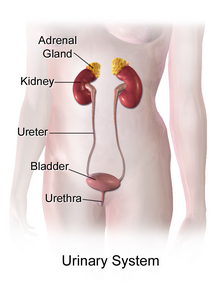 Global Information
Global InformationIdiopathic hypercalcinuria information
Idiopathic hypercalcinuria (IH) is a condition including an excessive urinary calcium level with a normal blood calcium level resulting from no underlying cause.[1] IH has become the most common cause of hypercalciuria and is the most serious metabolic risk factor for developing nephrolithiasis.[1] IH can predispose individuals to osteopenia or osteoporosis,[2] and affects the entire body. IH arises due to faulty calcium homeostasis, a closely monitored process, where slight deviations in calcium transport in the intestines, blood, and bone can lead to excessive calcium excretion, bone mineral density loss, or kidney stone formation.[1] 50%-60% of nephrolithiasis patients suffer from IH and have 5%-15% lower bone density than those who do not.[3]

The standard definition of hypercalciuria is varied. Hodkinson and Pyrah proposed hypercalciuria as a calcium excretion of over 7.5 mmol in men and 6.25 mmol in women, every 24 hours,[4] but some argue that these values are too restrictive and ignore age, weight considerations, and renal function. Calcium excretion is negatively associated with age until the ages of 30–60, where calcium excretion starts increasing. Calcium excretion begins decreasing following age 60.[4] Other suggested IH be considered a daily urinary excretion of >4 mg of calcium per kg of body weight,[3] making it more applicable among different age groups and weight classes.
IH shares many similarities with hyperparathyroidism, a condition associated with the elevated release of parathyroid hormone from the parathyroid gland.[5] The only discernable feature between the two is the normal blood calcium level associated with IH.

- ^ a b c Liebman, Scott E.; Taylor, Jeremy G.; Bushinsky, David A. (Feb 2006). "Idiopathic hypercalciuria". Current Rheumatology Reports. 8 (1): 70–75. doi:10.1007/s11926-006-0029-z. ISSN 1523-3774. PMID 16515769. S2CID 24660419.
- ^ Adams, John S. (1999-04-20). "Rapid Recovery of Bone Mass in Hypercalciuric, Osteoporotic Men Treated with Hydrochlorothiazide". Annals of Internal Medicine. 130 (8): 658–660. doi:10.7326/0003-4819-130-8-199904200-00012. ISSN 0003-4819. PMID 10215562.
- ^ a b Leslie, Stephen W.; Sajjad, Hussain (2022), "Hypercalciuria", StatPearls, Treasure Island (FL): StatPearls Publishing, PMID 28846247, retrieved 2022-04-13
- ^ a b Vezzoli, Giuseppe; Soldati, Laura; Gambaro, Giovanni (May 2008). "Update on Primary Hypercalciuria From a Genetic Perspective". Journal of Urology. 179 (5): 1676–1682. doi:10.1016/j.juro.2008.01.011. ISSN 0022-5347. PMID 18343451.
- ^ Halabé, A.; Sutton, R. A. (1987). "Primary hyperparathyroidism and idiopathic hypercalciuria". Mineral and Electrolyte Metabolism. 13 (4): 235–241. ISSN 0378-0392. PMID 3306315.